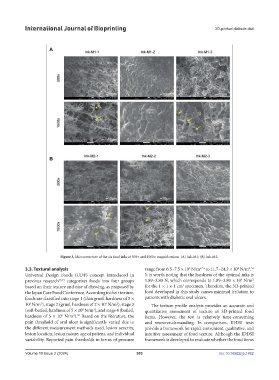Page 311 - IJB-10-2
P. 311
International Journal of Bioprinting 3D-printed diabetic diet
Figure 3. Microstructure of the six food inks at 500× and 1500× magnifications. (A) Ink-M1; (B) Ink-M2.
3.3. Textural analysis range from 6.5–7.5 × 10 N/m to 11.7–24.2 × 10 N/m .
4
2 52
2 51
3
Universal Design Foods (UDF) concept introduced in It is worth noting that the hardness of the optimal inks is
4
previous research 48,49 categorizes foods into four groups 1.89–3.80 N, which corresponds to 1.89–3.80 × 10 N/m
2
3
based on their texture and ease of chewing, as proposed by for the 1 × 1 × 1 cm specimen. Therefore, the 3D-printed
the Japan Care Food Conference. According to their texture, food developed in this study causes minimal irritation to
foods are classified into stage 1 (thin gruel, hardness of 5 × patients with diabetic oral ulcers.
10 N/m ), stage 2 (gruel, hardness of 2 × 10 N/m ), stage 3 The texture profile analysis provides an accurate and
4
2
2
3
(soft-boiled, hardness of 5 × 10 N/m ), and stage 4 (boiled, quantitative assessment of texture of 3D-printed food
2
4
hardness of 5 × 10 N/m ). Based on the literature, the items. However, the test is relatively time-consuming
2 50
5
pain threshold of oral ulcer is significantly varied due to and resource-demanding. In comparison, IDDSI tests
the different measurement methods used, lesion severity, provide a framework for rapid, convenient, qualitative, and
lesion location, lesion nature, age of patient, and individual intuitive assessment of food texture. Although the IDDSI
variability. Reported pain thresholds in terms of pressure framework is developed to evaluate whether the food items
Volume 10 Issue 2 (2024) 303 doi: 10.36922/ijb.1862

